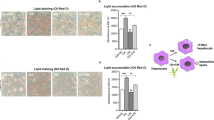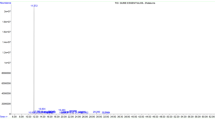Abstract
The main strategy to treat any type of cancer is to look for the therapeutic agents which specifically induce apoptosis in the malignant cells sparing normal cells. The present study was performed to investigate the potential cytotoxicity of alpha-tocopheryl succinate (α-TOS), a semi-synthetic vitamin E analog, in colon and liver cancer cells. α-TOS inhibited proliferation of HCT-116 and HepG-2 cells in a dose- and time-dependent manner. Here in, α-TOS induced cell cycle arrest at G0/G1 phase in both cell lines and triggered apoptosis via activation of caspase-9, thus initiating the caspase cascade in the intrinsic mitochondrial pathway. On the other hand, no significant change in the level of the antiapoptotic protein, Bcl-2 was detected. DNA fragmentation, a hallmark of apoptosis, was observed in HCT-116 cells after 48 h and in HepG-2 cells after 24 h treatment. Inhibition of angiogenesis was evident by a significant reduction (P < 0.001) in the VEGF protein levels after 24 and 48 h of α-TOS treatment, relative to the control values. Conclusively, α-TOS showed a promising anticancer activity through its apoptotic and antiangiogenic potentials in colon and liver tumor cells.





Similar content being viewed by others
References
Alleva R, Benassi MS, Pazzaglia L, Tomasetti M, Gellert N, Borghi B, Neuzil J, Picci P (2006) α-Tocopheryl succinate alters cell cycle distribution sensitising human osteosarcoma cells to methotrexate-induced apoptosis. Cancer Lett 232:226–253
Badamchian M, Spangelo BL, Bao Y, Hagiwara Y, Hagiwara H, Ueyama H, Goldstein AL (1994) Isolation of a vitamin E analog from a green barley leaf extract that stimulates release of prolactin and growth hormone from rat anterior pituitary cells in vitro. J Nutr Biochem 5:145–150
Basu A, Grossie B, Bennett M, Mills N, Imrhan V (2007) Alpha-tocopheryl succinate (α-TOS) modulates human prostate LNCaP xenograft growth and gene expression in BALB/c nude mice fed two levels of dietary soybean oil. Eur J Nutr 46:34–43
Bradford MM (1976) A rapid and sensitive method for the quantitation of microgram quantities of protein utilizing the principle of protein-dye binding. Anal Biochem 72:248–254
Carmeliet P (2005) Angiogenesis in life, disease and medicine. Nature 438:932–936
Fantin VR, Leder P (2006) Mitochondriotoxic compounds for cancer therapy. Oncogene 25:4787–4797
Folkman J (2007) Angiogenesis: an organizing principle for drug discovery? Nat Rev Drug Discov 6:273–286
Fukuzawa K, Kogure K, Morita M, Hama S, Manabe S, Tokumura A (2004) Enhancement of nitric oxide and superoxide generations by α-tocopheryl succinate and its apoptotic and anticancer effects. Biochemistry (Moscow) 69:50–57
Galluzzi L, Larochette N, Zamzami N, Kroemer G (2006) Mitochondria as therapeutic targets for cancer chemotherapy. Oncogene 25:4812–4830
Green DR, Reed JC (1998) Mitochondria and apoptosis. Science 281:1309–1312
Herrmann M, Lorenz HM, Voll R, Grunke M, Woith W, Kalden JR (1994) A rapid and simple method for the isolation of apoptotic DNA fragments. Nucleic Acid Res 22:5506–5507
Kogure K, Morita M, Nakashima S, Hama S, Tokumura A, Fukuzawa K (2001) Superoxide is responsible for apoptosis in rat vascular smooth muscle cells induced by α-tocopheryl hemisuccinate. Biochim Biophys Acta 1528:25–30
Kogure K, Hama S, Manabe S, Tokumura A, Fukuzawa K (2002) High cytotoxicity of α-tocopheryl hemisuccinate to cancer cells is due to failure of their antioxidative defense systems. Cancer Lett 186:151–156
Kumar S, Khanduja KL, Verma N, Verma SC, Avti PK, Pathak CM (2008) ATRA promotes alpha tocopherol succinate-induced apoptosis in freshly isolated leukemic cells from chronic myeloid leukemic patients. Mol Cell Biochem 307:109–119
Malafa MP, Neitzel LT (2000) Vitamin E succinate promotes breast cancer tumor dormancy. J Surg Res 93:163–170
Malafa MP, Fokum FD, Mowlavi A, Abusief M, King M (2002) Vitamin E inhibits melanoma growth in mice. Surgery 131:85–91
Moayyedi P (2008) Epidemiology and prevention of colorectal cancer. In: Jankowski J, Sampliner R, Kerr D, Fong Y (eds) Gastro-intestinal oncology, 1st edn. Blackwell, London, pp 293–304
Nagata S (2000) Apoptotic DNA fragmentation. Exp Cell Res 256:12–18
Neuzil J (2002) Alpha-tocopheryl succinate epitomizes a compound with a shift in biological activity due to pro-vitamin-to-vitamin conversion. Biochem Biophys Res Commun 293:1309–1313
Neuzil J, Weber T, Gellert N, Weber C (2001) Selective cancer cell killing by α-tocopheryl succinate. Br J Cancer 84:87–89
Neuzil J, Zhao M, Ostermann G, Sticha M, Gellert N, Weber C, Eaton JW, Brunk UT (2002) α-Tocopheryl succinate, an agent with in vivo anti-tumour activity, induces apoptosis by causing lysosomal instability. Biochem J 362:709–715
Neuzil J, Tomasetti M, Mellick AS, Alleva R, Salvatore BA, Birringer B, Fariss MW (2004) Vitamin E analogues: a new class of inducers of apoptosis with selective anti-cancer effect. Curr Cancer Drug Targets 4:267–284
Neuzil J, Wang XF, Dong LF, Low P, Ralph SJ (2006) Molecular mechanism of ‘mitocan’-induced apoptosis in cancer cells epitomizes the multiple roles of reactive oxygen species and Bcl-2 family proteins. FEBS Lett 80:5125–5129
Neuzil J, Dayson JC, Freeman R, Dong LF, Prochazka L, Wang XF, Scheffler I, Ralph SJ (2007) Mitocans as anti-cancer agents targeting mitochondria: lessons from studies with vitamin E analogues, inhibitors of complex II. J Bioenerg Biomembr 39:65–72
Ni J, Chen M, Zhang Y, Li R, Huang J, Yeh S (2003) Vitamin E succinate inhibits prostate cancer cell growth via modulating cell cycle regulatory machinery. Biochem Biophys Res Commun 300:357–363
Parkin DM (2001) Global cancer statistics in the year 2000. Lancet Oncol 2(9):533–543
Prasad KN, Kumar B, Yan XD, Hanson AJ, Cole WC (2003) α-Tocopheryl succinate, the most effective form of vitamin E for adjuvant cancer treatment: a review. J Am Coll Nutr 22:108–117
Qian M, Kralova J, Yu W, Bose HR, Dvorak M, Sanders BG, Kline K (1997) c-Jun involvement in vitamin E succinate induced apoptosis of reticuloendotheliosis virus transformed avian lymphoid cells. Oncogene 15:223–230
Ralph SJ, Dong LF, Low P, Lawen A, Neuzil J (2006) Mitocans: mitochondria-targeted anti-cancer drugs as improved therapies and related patents. Recent Pat Anticancer Drug Discov 1:305–326
Schindler R, Mentlein R (2006) Flavonoids and Vitamin E reduce the release of the angiogenic peptide vascular endothelial growth factor from human tumor cells. J Nutr 136:1477–1482
Shen MR, Droogmans G, Eggermont J, Voets T, Ellory JC, Nilius B (2000) Differential expression of volume-regulated anion channels during cell cycle progression of human cervical cancer cells. J Physiol 529:385–394
Skehan P, Storeng R, Scudiero D, Monks A, McMahon J, Vistica D, Warren JT, Bokesch H, Kenny S, Boyd MR (1990) New colorimetric cytotoxicity assay for anticancer drug screening. J Natl Cancer Inst 82:1107–1112
Sturla LM, Westwood G, Selby PJ, Lewis IJ, Burchill SA (2000) Induction of cell death by basic fibroblast growth factor in Ewing’s sarcoma. Cancer Res 60:6160–6170
Swettenham E, Witting PK, Salvatore BA, Neuzil J (2005) α-Tocopheryl succinate selectively induces apoptosis in neuroblastoma cells: potential therapy of malignancies of the nervous system? J Neurochem 94:1448–1456
Turley JM, Ruscetti FW, Kim SJ, Fu T, Gao FV, Birchenall-Roberts MC (1997) Vitamin E succinate inhibits proliferation of BT-20 human breast cancer cells: increased binding of cyclin A negatively regulates E2F transactivation activity. Cancer Res 57:2668–2675
Vindelov LL, Christensen IJ, Nissen NI (1983) A detergent-trypsin method for the preparation of nuclei for flow cytometric DNA analysis. Cytometry 3:323–327
Wang XF, Dong L, Zhao Y, Tomasetti M, Wu K, Neuzil J (2006) Vitamin E analogues as anticancer agents: Lessons from studies with α-tocopheryl succinate. Mol Nutr Food Res 50:675–685
Weber T, Lu M, Andera L, Lahm H, Gellert N, Fariss MW, Korinek V, Sattler W, Ucker DS, Terman A et al (2002) Vitamin E succinate is a potent novel antineoplastic agent with high tumor selectivity and cooperativity with tumor necrosis factor-related apoptosis-inducing ligand (TRAIL, Apo2L) in vivo. Clin Cancer Res 8:863–869
Weber T, Dalen H, Andera L, Négre-Salvayre A, Augè N, Sticha M, Loret A, Terman A, Witting PK, Higuchi M et al (2003) Mitochondria play a central role in apoptosis induced by α-tocopheryl succinate, an agent with anticancer activity. Comparison with receptor-mediated pro-apoptotic signaling. Biochemistry 42:4277–4291
Zandieh T, Fard AS, Aghaipur M (2003) Expression of Fas Antigen (CD95) on Human Leukemic Cells and Assessment of Apoptosis on Fas + and Fas- Samples by Flowcytometry Method. Iran J Allergy Asthma immunol 2(4):198–207
Zu K, Hawthorn L, Ip C (2005) Up-regulation of c-Jun-NH2-kinase pathway contributes to the induction of mitochondria-mediated apoptosis by α-tocopheryl succinate in human prostate cancer cells. Mol Cancer Ther 4(1):43–50
Author information
Authors and Affiliations
Corresponding author
Rights and permissions
About this article
Cite this article
Abd-El Fattah, A.A., Darwish, H.A., Fathy, N. et al. Promising antitumor effect of alpha-tocopheryl succinate in human colon and liver cancer cells. Med Chem Res 21, 2735–2743 (2012). https://doi.org/10.1007/s00044-011-9801-3
Received:
Accepted:
Published:
Issue Date:
DOI: https://doi.org/10.1007/s00044-011-9801-3




